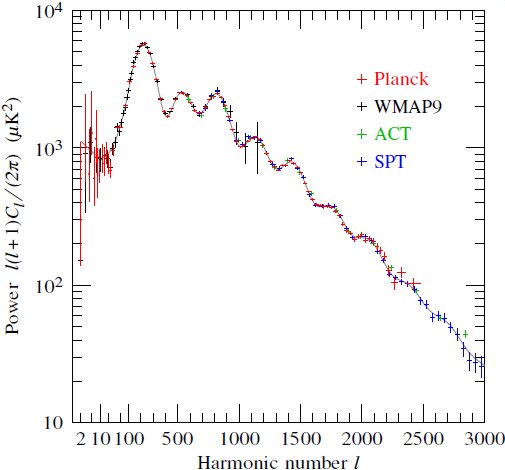 ASTR 5770 Fall 2021 Homepage
ASTR 5770 Fall 2021 Homepage
| syllabus | timetable | projects | problems | texts | images |
 Cosmology is the study of the Universe at large.
Over the last several decades
cosmology has developed into a huge subject,
fueled by observations of ever greater scope and precision.
The Rosetta Stone of modern cosmology is
the power spectrum of fluctuations in the Cosmic Microwave Background (CMB).
The observed power spectrum
agrees exquisitely well with the simplest prediction
of the theory of inflation.
Inflation postulates that the early (first 10−35 seconds)
Universe was dominated by the vacuum energy of an unknown scalar field,
and that perturbations were produced by quantum fluctuations of this field.
A major prediction, yet to be confirmed, is that inflation generates gravitational waves that,
if the energy scale of inflation is at the GUT scale of 1016 GeV or above,
should be detectable in the B-mode polarization of CMB fluctuations at large angular scales.
If detected, such waves offer a window to physics at GUT-scale energies inaccessible
to earthly experiment.
In 2014 the
BICEP2 team claimed a detection of B-mode polarization,
but this proved to be from spinning dust in our Galaxy, not primordial.
Although the CMB is the most important observational pillar of modern cosmology,
there are many other supporting observations.
One of the reasons for confidence is that all the observations put together
seem to support the same Standard \(\Lambda\)CDM Model of Cosmology.
This course aspires to cover the following topics
(the first item is in capitals because of its importance):
Cosmology is the study of the Universe at large.
Over the last several decades
cosmology has developed into a huge subject,
fueled by observations of ever greater scope and precision.
The Rosetta Stone of modern cosmology is
the power spectrum of fluctuations in the Cosmic Microwave Background (CMB).
The observed power spectrum
agrees exquisitely well with the simplest prediction
of the theory of inflation.
Inflation postulates that the early (first 10−35 seconds)
Universe was dominated by the vacuum energy of an unknown scalar field,
and that perturbations were produced by quantum fluctuations of this field.
A major prediction, yet to be confirmed, is that inflation generates gravitational waves that,
if the energy scale of inflation is at the GUT scale of 1016 GeV or above,
should be detectable in the B-mode polarization of CMB fluctuations at large angular scales.
If detected, such waves offer a window to physics at GUT-scale energies inaccessible
to earthly experiment.
In 2014 the
BICEP2 team claimed a detection of B-mode polarization,
but this proved to be from spinning dust in our Galaxy, not primordial.
Although the CMB is the most important observational pillar of modern cosmology,
there are many other supporting observations.
One of the reasons for confidence is that all the observations put together
seem to support the same Standard \(\Lambda\)CDM Model of Cosmology.
This course aspires to cover the following topics
(the first item is in capitals because of its importance):
| Problem Sets | 70% |
| Project | 15% |
| Final | 15% |
 Fall 2021 ASTR 5770 Homepage
Fall 2021 ASTR 5770 Homepage
| syllabus | timetable | projects | problems | texts | images |